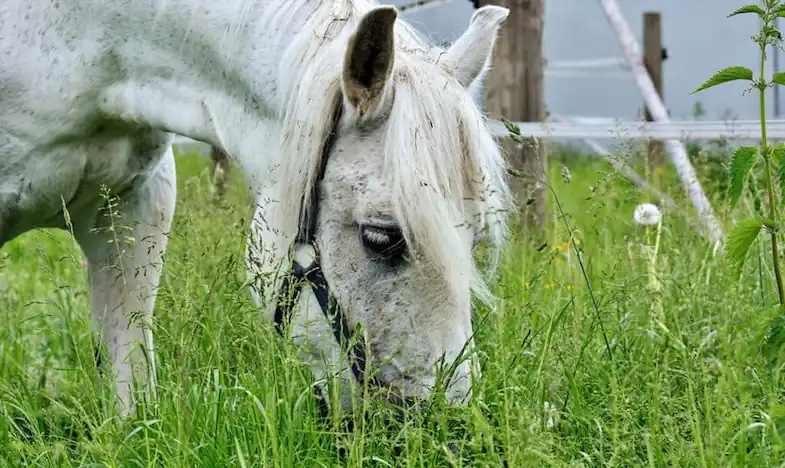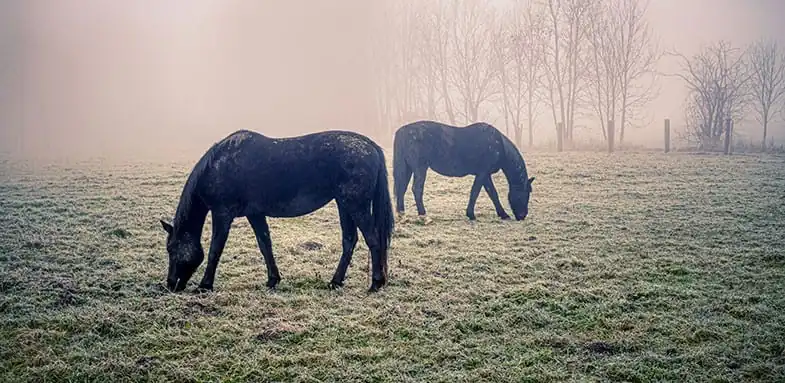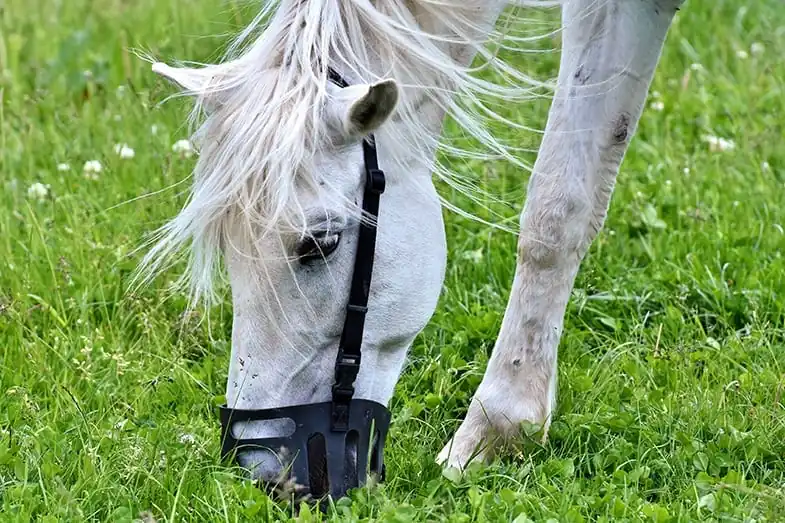I’m lucky enough to live in an area that doesn’t have an excessive amount of rain but I was recently speaking to a friend (who lives in Louisiana) who was complaining about all of the rain spoiling the grass. This started me thinking about whether or not wet grass was okay for horses to eat. After doing some research into this I was surprised by what I found.
Is it bad for horses to eat wet grass? The simple answer is yes eating wet grass can be extremely bad for horses, especially if they are prone to colic. The reason for this, according to veterinarians, is because short wet grass will start to ferment before it reaches the horse’s stomach.
While many of us may be hesitant to turn out horses out if the pasture is waterlogged there could still be a fair amount of water in wet but non-waterlogged grass which could, in some cases, cause a problem for your horse. The real question though is how wet is too wet and what are the consequences of feeding wet grass to horses?
How wet is too wet for horses to eat?
There are no set rules to the amount of water grass can have before horses should stop eating it because after all, all horses are different, and different horses will be able to deal with different amounts of water. If your horse is prone to bouts of colic or is insulin resistant then the amount of water they can safely consume will be less than if they weren’t.
That said though, as a very rough guide if it’s been raining heavily for a few hours it will probably be okay but anything longer is better to avoid.
Can eating wet grass cause horses to colic?
You might not think there is any connection between horses eating wet grass and colic but because they’re not able to get rid of the water quickly enough there is actually a very big, and real, risk. The problem is that the grass has a very high water content but this water can’t just pass through the horse as if they were drinking. Therefore the water ends up sitting in the horse’s stomach, and when the horse eats more grass the stomach will try to expand, this can then lead to colic.
Is dew-covered grass bad for horses?
There are a lot of myths and rumors out there that say allowing horses to eat dew-covered grass will cause laminitis but recent research has shown that not only is this completely wrong it may in fact be the opposite of what’s true.
Like a lot of living plants, grass needs sunlight to create fructan (the sugar that plants need to grow), but during the night there’s no sun so, while they may hold onto these plant sugars, they don’t produce anymore. While this might indicate morning grass is bad for horses, this is the time when the grass starts to grow which therefore means the dew (which can also help the grass grow) forces the grass to use its fructan reserves.
This means that the morning dew-covered grass is in fact probably the safest for horses that are prone to laminitis, while the warm summer afternoons and evenings are the worst because the sun has enabled the grass to produce an abundance of fructans.
What can you do to reduce the amount of wet grass your horse eats?
If you live in an area that has a high rainfall you’ll know it can be really difficult to stop your horse from eating a lot of wet grass, even if they’re only turned out for short periods of time but there are a few things that you can do to keep them healthy, allow them access to good quality grass and still keep the amount of water they consume to a minimum.
Turn out after meals, rather than before
While this may not be practical all of the time, especially if you’re not able to visit your horse multiple times every day, turning your horse out straight after they’ve had a meal or finished their hay can go a long way to reducing how much wet grass they eat. Horses are trickle feeders and, while there will always be the exception to the rule, generally won’t eat a large amount of grass (wet or otherwise) straight after a meal.
Grazing Muzzle
Any owner (especially those of ponies) will tell you that restricting grazing just leads to gorging but, providing the grass isn’t so short it won’t fit through it a grain muzzle can be a great way of reducing how much grass your horse can eat. Research has shown that horses using a muzzle will eat between 70 and 80% less grass than those without. Which is perfect for gorgers on restricted grazing, especially as they shouldn’t be worn for more than 10 hours a day.
All horses are different and some won’t take to wearing a muzzle which is why I prefer to use ones with a padded lining (ideally fleece). It reduces the chances of rubbing and therefore makes them more acceptable for fussy horses.
Very restricted grazing (but more hay)
Horses need to forage but that doesn’t mean to say they have to do it all day on grass. If you’re able to keep your horse in for most of the day and only turn him out for an hour or two that can really reduce how much wet grass he eats.
You can still satisfy your horse’s foraging instincts by feeding him more hay and either using slow feeders or feeding it directly on the floor. This will also help to keep him occupied if you do have to keep him stalled for most of the day.
If you’re worried about your horse being bored while he’s cooped up inside you might find this recent article I wrote about reducing boredom in horses on stall rest helpful.
Reduced grazing WITHOUT a stall
It can be difficult to restrict your horse’s grazing if you’re not able to stable him at any time but that doesn’t mean you can’t restrict his grazing though. Turning your horse out in a sandy area (or arena) can be a great way of restricting your horse’s access to wet grass.
This of course does comes with its own set of drawbacks which, if not addressed, could be just as serious as allowing your horse to eat wet grass. The problem with sand is that if horses eat too much sand it can sit undigested in their stomach which can lead to sand colic. This is why, if you are turning your horse out in a sandy area you shouldn’t allow them to eat directly from the ground and should also consider adding psyllium to their diet. Psyllium is a plant whose husks can help to remove undigested material from a horse’s digestive tract.
Related questions
Can horses eat hay that’s been rained on?
Unless your horse is prone to colic there is nothing wrong with feeding hay that has been rained on (even if it’s monsoon rain) as long as it hasn’t started to go moldy. After all, if you free feed hay to horses there’s every chance it’ll be rained on before it’s all been finished, especially if you’re feeding round bales that may take a few days to be completely consumed.
How long does a horse need to graze for?
Horses are trickle feeders which means they won’t eat a huge amount of food in one go but will instead eat a little bit often. This means that if you add up how much time a horse spends grazing in a single day it will normally be anything up to 10 hours. That is just grazing though and doesn’t include how long they spend eating their feed as well.
Shop the article
If you want to buy any of the products I mention in this article you can order them directly from Amazon using the links below. While I do make a very small percentage on each sale I only ever recommend products I feel would be beneficial and would never recommend a product just because of a commission.
Further reading
- Feeding a horse without pasture
- Horse feed explained
- Dos and don’ts of feeding treats
- Are bananas okay for horses to eat?
- 20 fruits your horse will love
- Foods your horse should have
- The benefits of coconut oil
- What should your horse weigh?
- Reducing an easy keeper’s weight
- Beginners guide to horse care
I hope you found this article helpful. If you did I’d be grateful if you could share it please as it would really help me.
Recommended products
Over the years I have tried hundreds of different horsey products, from various blankets and halters to different treats. Some I’ve loved, others I’ve hated but I thought I’d share with you my top all-time favorite products, the ones I never leave the yard without. I’ve included links to the products (which are in no particular order) that I really think are great.
- Horse Knots by Reference Ready – If you’re like me and enjoy pocket reference guides then you’ll love this knot tying guide. These handy cards can easily fit in your pocket or attach to the saddle for quick reference. They’re waterproof, durable and are color coded to make them easy to follow.
- Mane ’n Tail Detangler – Even if you never show your horse you’ll need to detangle his tail from time to time (and possibly his mane too) which is always a challenging chore! I’ve found that if I run a little bit of detangler through my horse’s tails every few days it stops them from getting matted up and makes combing them easy, even if they’re coated in mud. I don’t know if I should admit to this or not but it also works wonders on my hair.
- TAKEKIT Pro clippers – Over the years I’ve tried a lot of different clippers and while some were obviously better than others I found these to be by far the best. They are heavier than a lot of other clippers but for me, that’s a good thing, it makes them feel more sturdy and hardwearing. On top of that they have a range of speeds so are just as good for clipping your horse’s back as they are his face. I also like the fact that they come in a handy carry case but that’s not for everybody. The company that makes them is super good and incredibly helpful too, a real bonus these days. The only thing I wasn’t keen on was the fact that it doesn’t come with any oil, but that’s not a major problem as it’s not difficult to buy lubricant.
- Shire’s ball feeder – There are so many boredom buster toys out there but I like to use these every day, regardless of whether or not my horses are bored. I find that it helps to encourage my horses to problem solve by rewarding them with treats (or pieces of fruit) but it also mimics their natural grazing behavior which helps to keep them calm and de-stressed.
- Horse safe mirror – This is a strange one that many people are surprised about but I like to put horse safe mirrors in the trailers as well as in the quarantine stalls. It helps to prevent the feeling of isolation by giving the impression of other horses being around. Being herd animals horses can get extremely stressed when they feel that they’re on their own but with these stick-on mirrors, they believe that at least one other horse is with them.
- Rectal thermometer – I know this isn’t glamourous at all but it’s vital for your horse’s well-being to be able to check their temperature and a rectal thermometer is the easiest way of doing this which is why I’ve added it to the list.
Shopping lists
I’ve also put together a few shopping lists of essential items that I’ve found helpful over the years. I’ve broken the lists down into different categories rather than put everything in one massive list 😉




